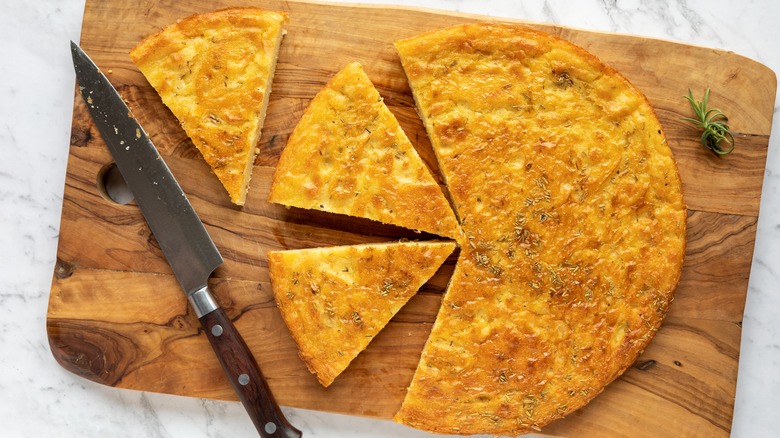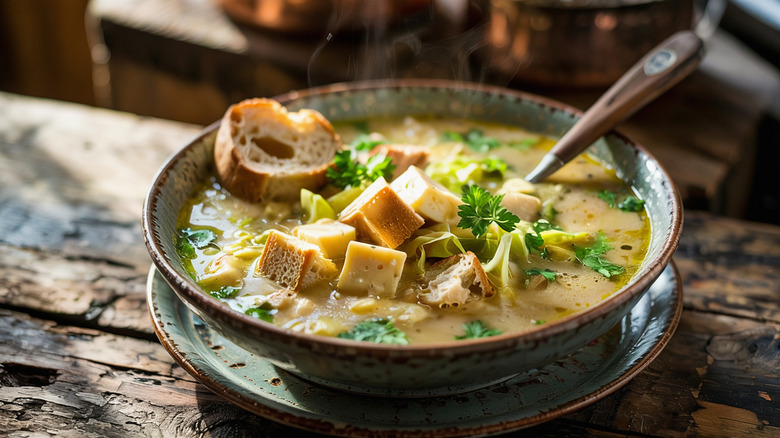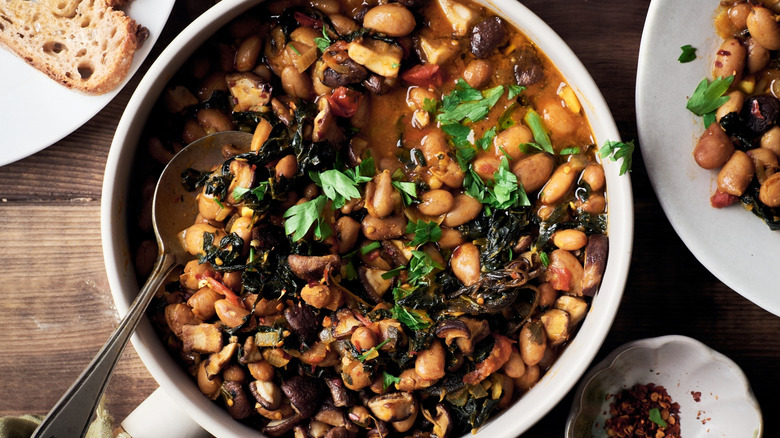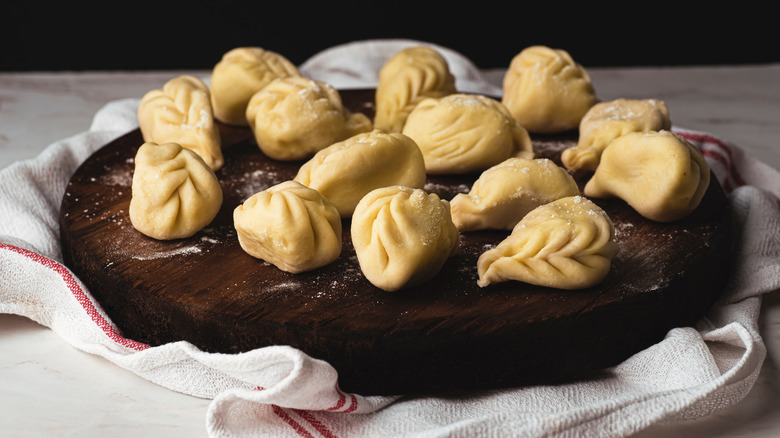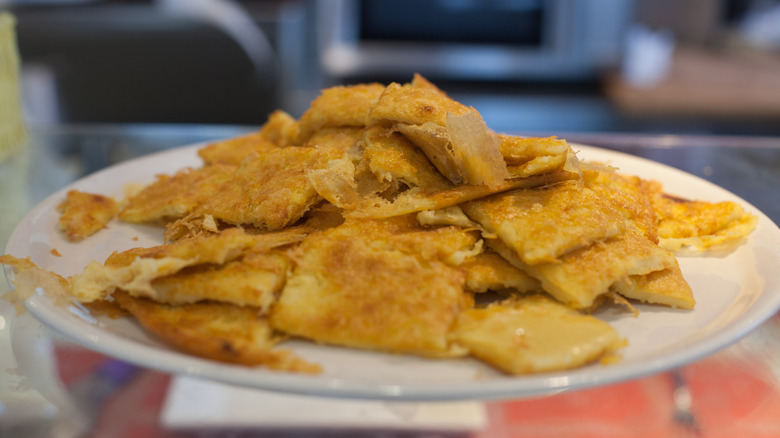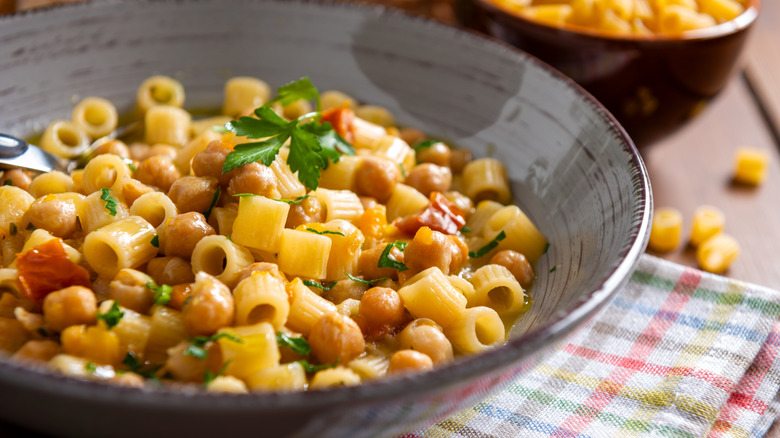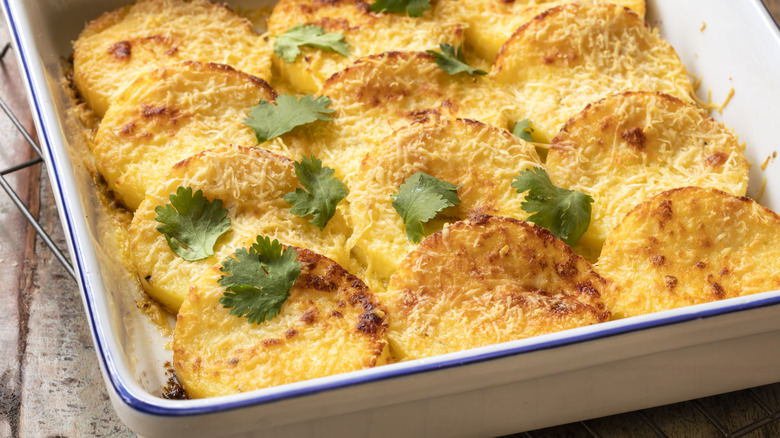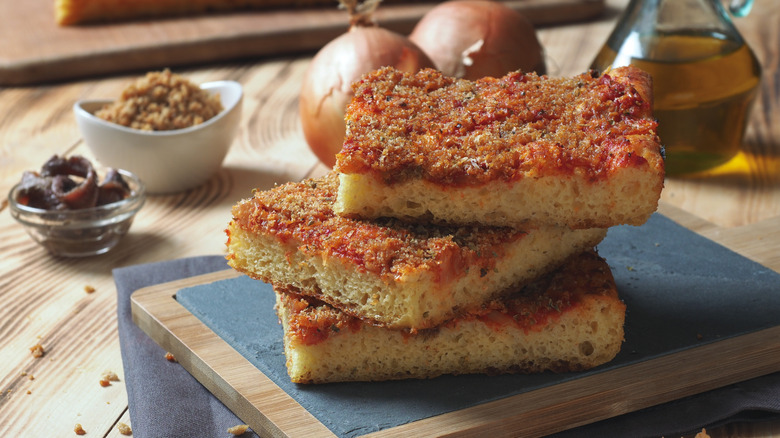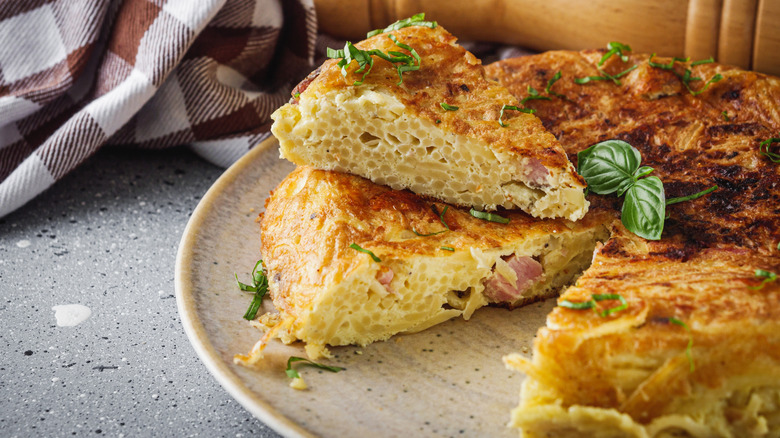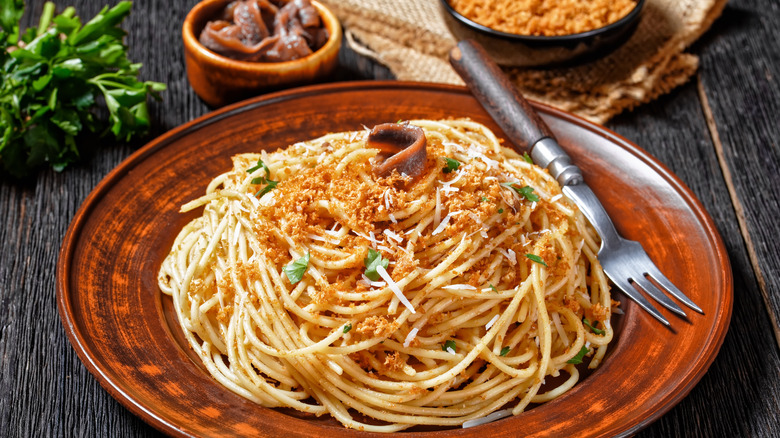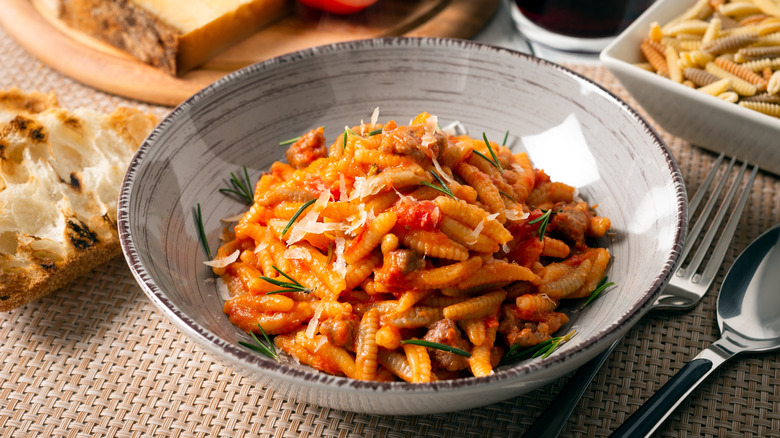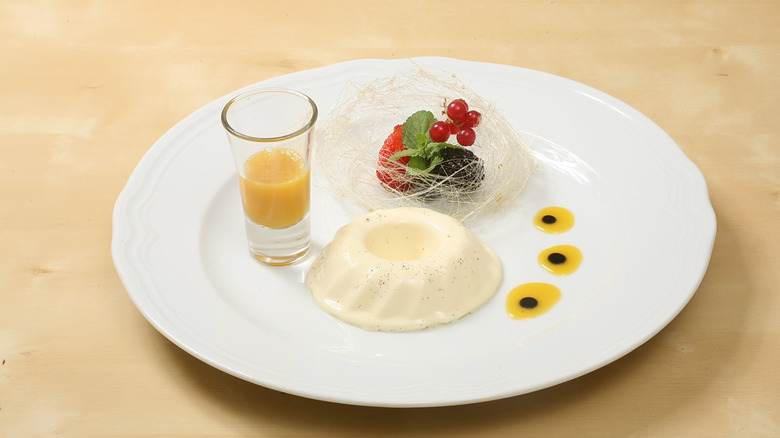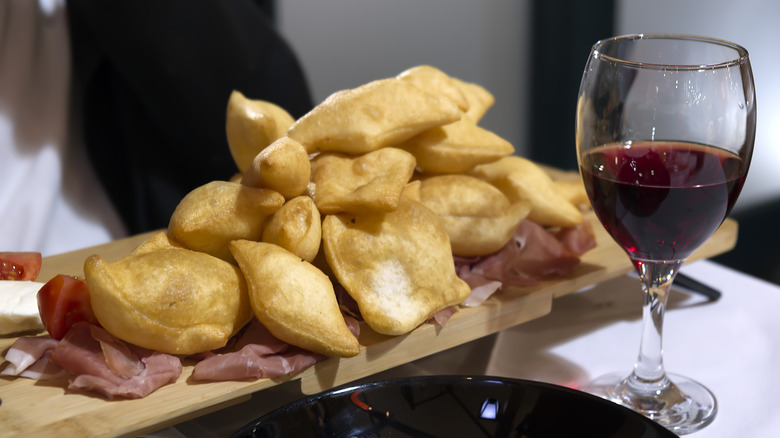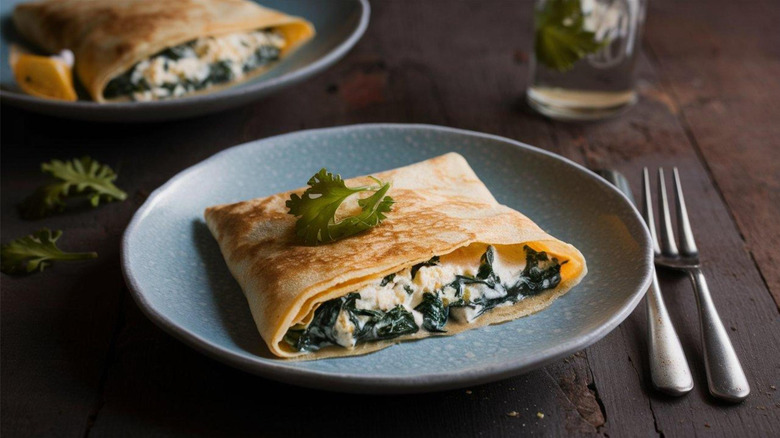Old-School Italian Dishes You Might Not Have Heard Of
Italian food isn't all Neapolitan pizza and Alfredo sauce — the nation has a rich culinary history with lots of surprises for anyone who's only ventured into the popular options. There are many old-school Italian dishes you might not have heard of. The kinds of dishes your nonna might spend all afternoon cooking — and I would know, having a nonna who still lives on the Italian island of Sardinia.
From regional specialties that people have been eating for centuries to homey recipes that would never find their way onto restaurant menus, these dishes are all traditional fare with a long history. They have old-school vibes and are well-known in Italy, particularly among older generations, but outside of the country, you probably won't encounter them.
Whether you're looking for dinner ideas or simply curious about Italian cuisine, these lesser-known dishes may be vintage, but they are ones that Italians enjoy both at home and as traditional street foods.
Zuppa alla Valpellinentze
Zuppa alla Valpellinentze is one of those deeply rustic Italian dishes that rarely appears on restaurant menus outside its home region, but it deserves more attention. It comes from Valpelline, a small valley in the Aosta region of northern Italy, where winters are long and harsh. This isn't a delicate soup; it's hearty mountain food designed to keep you full and warm.
The dish is built from just a few ingredients: stale bread, cabbage, broth, and plenty of Fontina cheese, the semi-soft cow's milk cheese for which Aosta is famous. Rather than the kinds of herbs you might expect in Italian food, it's seasoned with cinnamon. Unexpected in the U.S., sure, but proof that cooking in Italy is highly regional with variations that don't match the classical canon.
To make this soup, bread and cabbage are layered in a baking dish with slices of Fontina, then topped with broth and baked until everything is well-melded. What comes out of the oven isn't a clear soup at all but something closer to a casserole. It's thick, rich, and deliciously cheesy.
Traditionally, families would make it with bread that was too hard to eat on its own, stretching leftover ingredients into a filling meal. While it may look simple, the combination of good bread, tender cabbage, and melting Fontina is surprisingly complex. It's Alpine soul food at its best.
Pisarei and fasö
Pisarei e fasö is an old-school classic that's not dissimilar from a pasta e fagioli recipe, but with a regional twist. Somehow, it manages to taste like home even if you've never been to Emilia-Romagna, where it's from. But the dish is more than just traditional: it's ancient, likely dating back to the Middle Ages.
Pisarei is the name for tiny dumplings made from a simple dough of flour and breadcrumbs (often made with stale bread), rolled into little thumb-sized shapes, while fasö is a regional word for beans. The dumplings are deliberately small and slightly firm, so they grab onto sauce the way good pasta should. Traditionally, the beans are borlotti or cannellini, cooked into a thick, tomato-based ragu that's built on a soffritto of onions and sometimes supplemented with a bit of pancetta or lard for added depth.
What makes the dish special is the texture: the toothy pisarei against the creamy beans. In homes around Piacenza, where the recipe is most closely associated, it likely originated as a way to stretch a handful of inexpensive ingredients into a filling, protein-rich meal. However, these days, it's a meal the region is proud of, not just a way to save money and resources. Like many traditional Italian recipes, the simplicity is part of the appeal, but a generous dusting of Parmigiano-Reggiano and a drizzle of high-quality extra-virgin olive oil never goes amiss.
Culurgiones
Culurgiones are Sardinia's answer to stuffed pasta, but they aren't just another ravioli. These handmade pockets are typically filled with a mixture of mashed potatoes, Pecorino Sardo, and fresh mint. This added bright, herbaceous note keeps the filling from feeling heavy. The real signature, though, is the seal: Each culurgione is closed with a distinctive pleat that looks like an ear of wheat. That little braid isn't decorative alone. It's a traditional mark of care, and in many villages, a symbol of good luck or a wish for a bountiful harvest.
You'll find culurgiones most often in eastern Sardinia, Ogliastra, and in nearby areas. They're tricky to shape, but once made, they're easy to cook. A short simmer in salted water and they're ready, usually finished with a light tomato sauce, melted butter and sage, or simply a drizzle of good olive oil and extra Pecorino.
This isn't the kind of thing you'll find in a restaurant, but if you want to make them at home, there are plenty of recipes out there. Just be sure to avoid the same kinds of mistakes people make with homemade ravioli.
Farinata
If you've been wondering how to use that bag of chickpea flour, farinata is the perfect solution. Made from chickpea flour, water, plenty of olive oil, and a pinch of salt, farinata is a thin, blistered pancake baked until the edges lace and the center stays slightly creamy.
In Liguria, farinata is sold at Genoa's neighborhood bakeries and in paper-wrapped slices at markets. But versions turn up across Italy and southern France as socca in Nice, cecina in Tuscany. It might not sound particularly exciting, but the olive oil gives it a richness that makes it satisfying. Take a bite and you'll understand why people have been eating it since the 13th century. How's that for old-school?
Farinata is often sold as street food, cut into wedges and eaten hot. It's naturally gluten-free and vegan, high in protein, and totally moreish.
Pasta e ceci
Pasta e ceci is a traditional Italian dish that nearly every household has its own version of. It's made with dried chickpeas (or canned for a quicker dinner), typically small, shaped pasta like ditalini or quadretti, and your choice from a variety of aromatics. My nonna's pasta e ceci is simple and soupy with whole chickpeas and chunks of onion, carrot, and celery. Others blend the chickpeas so it's more like a creamy pasta sauce. Some versions are tomato-forward, while others go without; garlic, rosemary, or bay might be the main aromatics, while others rely on a soffritto. There are so many ways to make this dish that it's not the same in any two households.
This pasta is versatile: serve it brothy as a first course or reduce the liquid until the pasta has absorbed most of it and serve it as a humble main. Finish with a drizzle of good extra-virgin olive oil, a grind of black pepper, and a generous sprinkling of grated cheese, if desired.
This is the kind of meal that's easy to elevate with one careful choice: better oil, fresher herbs. But perfectly fine in its simplest form, which is precisely why it has been a weekday staple in Italian kitchens for generations. It may not win awards for flair, but it makes for excellent home cooking.
Gnocchi alla Romana
You might think you know this one, but this is not your usual gnocchi recipe. Gnocchi alla Romana often surprises people because they expect little potato dumplings, but that isn't what shows up. These gnocchi are discs of baked semolina. To make it, semolina is simmered with milk (or a milk-water mix), butter, and grated cheese until it becomes a thick, spoonable polenta-like paste. Once it's firm, chill it, cut rounds with a glass or cookie cutter, arrange them in a buttered baking dish, and dot with more butter and cheese. Then, bake until the tops are golden and slightly crisp.
This dish is popular in Lazio, the region where Rome is located. It's the kind of thing traditional cooks might make at home, but you can also find it in restaurants in Rome, especially those catering to tourists looking for traditional dishes. When in Rome, literally, gnocchi alla Romana is something you should absolutely seek out, but it's not about to become an American-Italian staple any time soon.
Sfincione
Even if you think you're in the know about regional pizza styles, you probably haven't heard of sfincione. It's Palermo's thick, rustic answer to pizza. It's a spongy, oil-rich focaccia-like bread made from a high-hydration dough, baked in a rectangular pan until the crumb is airy and almost cake-like. The classic topping is simple: a slow-simmered tomato sauce and a scattering of toasted breadcrumbs. Older versions also included anchovies and Sicilian raw sheep's milk cheese called tuma.
Sfincione's history is disputed. Some say it dates back to the 1600s, when it was made in the kitchens of Prince Giuseppe Branciforte di Butera. Others say it was invented in the 1800s by bakers in the region. Either way, it's long been enjoyed as a street food on the island. Making it well is about getting the dough light and the toppings balanced — too much oil and it's cloying, too little and the crumb feels dense. And those breadcrumbs are essential: they add a dry, crunchy counterpoint to the oily, saucy surface.
Frittata di spaghetti
Frittata di spaghetti is proof that leftovers don't have to be boring. Common across Italy for decades, it's essentially a spaghetti omelette. Cold, cooked pasta is mixed with beaten eggs, cheese, and any extras you have (such as peas, tomatoes, or sautéed vegetables), then fried until the outside is crisp and the inside is set. Some families finish it under a broiler or flip it to brown both sides; others bake it in a pan, but the outcome is much the same. It's a traditional Neapolitan dish, but its reach has spread across the country.
For anyone unsure, think about it: an omelette and spaghetti dinner combined. What's not to love? It's economical, too — a way to feed a crowd from a pot of yesterday's spaghetti. My nonna used to make it when I was a kid, when we had too much pasta left from dinner. She'd cook up onions and peas and mix them through, which brought extra sweetness and flavor. And, of course, you don't have to make it with spaghetti; any noodles will do the trick.
Pasta mollicata
Pasta mollicata — literally meaning pasta with crumbs — is another classic example of a simple dish that's way more delicious than the sum of its parts. Breadcrumbs are used to top pasta, bringing both texture and a toasty, nutty flavor. Depending on where you are (or who's making it), mollicata can be very plain with just some olive oil and garlic on the noodles, or more elaborate, with ingredients such as walnuts or raisins. Traditionally, this may have been the kind of dish people would make to use up whatever was available, which is why the specifics vary so much.
There are many ways to make this dish, but all involve toasting stale breadcrumbs in plenty of olive oil until golden and crunchy. The best part is the textural contrast — the soft pasta against the crunch of the toasted crumb. Plus, you've got to love the way inexpensive components turn into something delicious. It's a weekday supper that people have been enjoying in Italy for generations. It's a level up from plain noodles but without much extra effort.
Malloreddus alla Campidanese
There are plenty of old-school pasta sauces that aren't marinara — and malloreddus alla Campidanese features one of them. Additionally, it features an unusual pasta shape that many people may not be familiar with. Malloreddus are Sardinia's most iconic pasta shape. They're sometimes known as Sardinian gnocchi, but they're far from the potato dumplings. These are short, chewy shapes with ridges that hold onto sauce brilliantly.
The Campidanese version dresses them in a pork-and-sausage ragu scented with saffron, fennel seed, and plenty of grated Pecorino Sardo. The saffron gives the sauce a warm color and a faint floral note that sets it apart from mainland ragu. In rural Sardinia, you'll still find families making the pasta the way they have for generations. It's made by hand from semolina and water, pressing the dough over a ridged surface or gnocchi board to create those grooves that trap every bit of sauce.
While it is traditionally a meat-heavy dish, I've made plenty of veggie versions using meat-free sausages, which work just as well as the original. It's a hearty dish that's made for the cool winters in the mountainous interior of the island.
Biancomangiare
Biancomangiare, which literally means "white food," is a medieval dish that has endured into modern times. Back in the 14th century, it was found on the banquet tables of the nobility. It was made with white meat, such as chicken breast, along with sugar and a starch to thicken it. Today, this Sicilian classic has turned into a delicate almond-milk pudding.
It's a white set dessert made from sweet almond milk (or whole milk) thickened with cornstarch, gently perfumed with lemon peel, cinnamon, or orange-blossom water, and finished with chopped pistachios or a drizzle of honey. It's a great example of how dishes change, given enough time. It originated as a type of jellied meat dish and evolved into a dessert similar to panna cotta.
And, even though it's been around such a long time, it's not a thing of the past. People make it at home, especially in Sicily, and it can be found on some restaurant menus. However, it's not the kind of dish most people have heard of outside Italy.
Gnocco fritto
If you've only met gnocchi as potato dumplings, gnocco fritto will change your classification system. From Emilia-Romagna, this dish (that is also called crescentina or torta fritta in nearby towns) is a fried, leavened flatbread. It's made from sheets of dough cut into pieces, fried until they puff and blister, and then eaten hot, often accompanied by meats and cheeses. It likely dates back to the 6th century, when the fall of the Roman Empire brought Germanic people and new types of cuisine to the area.
The dough is straightforward. You just need flour, water (or milk), a bit of lard or oil, and yeast. The transformation happens by frying these little pieces of dough, making them crisp and delicious. It's one of the best-known dishes in the Emilia-Romagna area, often served as street food or in bars or restaurants. However, despite its history and popularity, it has not made its way across the pond.
Crespelle
Crespelle are essentially Italian crêpes that may date back to the 1500s. In Tuscany, they become crespelle alla Fiorentina, filled with spinach and ricotta, rolled, then topped with béchamel and tomato sauce or simply baked under a blanket of grated cheese. Elsewhere, crespelle can be sweet or stuffed with a variety of savory ingredients, such as mushrooms, seafood, or ricotta and herbs. These pancakes are often treated more like fresh pasta than like French crêpes.
They're made from eggs, milk, and flour, whisked until smooth, and cooked in a well-buttered pan — but the Italian way often makes these pancakes more like a gratin. Sometimes they're layered in a dish and baked until the edges crisp, while others are rolled around a filling, like cannelloni. Sure, this isn't the quickest way to make dinner — frying up a load of crespelle before you've even started on the filling — but it makes a special dish that you'll want to keep coming back to.
